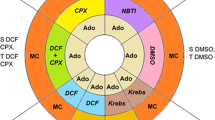Summary
Adenylate kinases, small organ-specific isoenzymes which appear after tissue damage in the blood plasma are partly eliminated via the kidney. After intravenous administration of 3000 enzyme units of14C-labelled adenylate kinase to rats, about 50% of the enzyme and of the radioactivity are found in the urine within 7 minutes.
The elimination of adenylate kinase from the serum occurs in two phases, a faster (half-life 16 minutes) and a slower (half-life 160 minutes). After intravenous administration of adenylate kinase to humans, a part of the activity was recovered in the urine within minutes. The potential use of assaying adenylate kinase levels for early diagnosis of myocardial infarction is discussed. Using various skeletal muscle diseases as examples, the possible use of the very rapid elimination of adenylate kinase from the serum in monitoring the course of the acute illnesses is described.
The competitive inhibitor diadenosine pentaphosphate (AP5A) has a much higher affinity for the adenylate kinases from erythrocytes, heart or skeletal muscle than for the isoenzymes from liver or kidney. Therefore, AP5A can be used for the differential determination of adenylate kinase isoenzymes in the blood plasma or the urine.
Zusammenfassung
1. Adenylatkinasen, kleine organspezifische Isoenzyme, die nach Zellschädigungen im Serum nachweisbar sind, werden teilweise durch die Niere eliminiert. Bei der Ratte erschienen nach Applikation von 3000 Enzymeinheiten14C-markierter Adenylatkinase (AK) innerhalb von 7 min etwa 50% cer Enzym- und der Radioaktivität im Urin.
2. Beim Menschen erfolgt die Elimination von AK aus dem Plasma in zwei Phasen, einer schnelleren (Halbwertszeit 16 min) und einer langsameren (Halbwertszeit 160 min). Ein Teil der in Selbstversuchen injizierten Enzymaktivität ließ sich in wenigen Minuten im Urin nachweisen. Die potentielle Bedeutung von AK-Bestimmungen in Urin und Plasma für die Früh-und Rezidivdiagnostik des Herzinfarkts wird diskutiert. — Am Beispiel verschiedener Skeletmuskelerkrankungen werden Möglichkeiten gezeigt, die extrem rasche Elimination von AK aus dem Serum für Verlaufskontrollen auszunutzen.
3. Der kompetitive Inhibitor Diadenosinpentaphosphat (AP5A) hat eine sehr viel höhere Affinität zu den Adenylatkinasen aus Erythrocyten, Herz- und Skeletmuskel als zu den Isoenzymen aus Leber und Niere. AP5A kann deshalb zur Differentialbestimmung von Adenylatkinase-Isoenzymen im Plasma oder im Urin verwendet werden.
Similar content being viewed by others
Literatur
Bär, U., Ohlendorf, S.: Studien zur Enzymelimination. I. Halbwertszeiten einiger Zellenzyme beim Menschen. Klin. Wschr.48, 776 (1970)
Bernstein, H.L., Horenstein, J.M., Russell, P.J.: Adenylate kinase in human tissues. II. Serum adenylate kinase and myocardial infarction. J. Mol. Cell. Cardiol.5, 71 (1973)
Heil, A., Müller, G., Noda, L., Pinder, T., Schirmer, R.H., Schirmer, I., von Zabern, I.: The Amino-Acid Sequence of Porcine Adenylate Kinase from Skeletal Muscle, Eur. J. Biochem.43, 131 (1974)
Heyck, H., Laudahn, G., Lüders, C.J.: Fermentaktivitätsbestimmungen in der gesunden menschlichen Muskulatur und bei Myopathien II. Enzymaktivitätsänderungen im Muskel bei Dystrophia musculorum progressiva. Klin. Wschr.41, 500 (1963)
Kleine, T. O., Chlond, H.: Die Aktivität der Myokinase (Adenylatkinase) und der Creatinkinase in Serum und Muskel bei der progressiven Muskeldystrophie (Erb). Klin. Wschr.44, 103 (1966)
Kubo, S., Noda, L.H.: Adenylate kinase of porcine heart. Eur. J. Biochem.48, 325 (1974)
Lehmann, F.-G., Schneider, K.W., Menge, H.: Die enzymatische Diagnostik des Herzinfarktes. II. Mitteilung: Die Bestimmung von organspezifischen Enzymen: Kreatinphophokinase und Myokinase. Enzymol. Biol Clin.6, 35 (1966)
Lienhard, G.E., Secemski, I.I.: P1P5-Di(adenosine-5′)pentaphosphate, a Potent Multisubstrate Inhibitor of Adenylate Kinase. J. Biol. Chem.248, 1121 (1973)
Madritsch, K.: Die Myokinase in der Diagnostik des Herzinfarktes. Schweiz. med. Wschr.98, 646–653 (1968)
Mainzer, K., Morsches, B., Holzmann, H.: Serum Myokinase (Adenylate Kinase) Activity in Intravascular Hemolysis. Ärztl. Forsch.26, 426 (1972)
Mattenheimer, H.: Enzyme im Urin. In: Methoden der enzymatischen Analyse (ed.: H.M. Bergmeyer), 3rd ed., Vol. I, p. 64. Weinheim/Bergstr.: Verlag Chemic (1974)
Noda, L.: Adenylate Kinase. In: The Enzymes, 3rd ed., Vol. III, (ed.: P.D. Boyer) Part A, p. 279. New York and London: Academic Press (1973)
Pradham, T.K., Criss, W.E.: Modulation of Mitochondrial Adenylate Kinase by Citric-Acid-Cycle Intermediates, Eur. Biochem.43, 541 (1974)
Price, N.C., Schirmer, R.H., Cohn, M.: Studies on the environments of the sulfhydryl groups of porcine muscle adenylate kinase. J. Biol. Chem., im Druck
Russell, P.J., Jr., Horenstein, J.M., Goins, L., Jondes, D., Laver, M.: Adenylate Kinase in Human Tissues. I. Organ Specificity of Adenylate Kinase Isoenzymes. J. Biol. Chem.249, 1874 (1974)
Schirmer, R.H., Thuma, E.: Sensitivity of adenylate kinase isoenzymes from normal and dystrophic human muscle to sulfhydryl reagents. Biochim. Biophys. Acta268, 92 (1972)
Schmidt, F.H.: Über die Bestimmung der Myokinase-(Adenylatkinase-)Aktivität in Serum. Klin. Wschr.42, 476 (1964)
Schreiber, F.-K.: Myokinasebestimmungen in der Diagnostik des Herzinfarkts. Klin. Wschr.42, 478 (1964)
Schulz, G.E., Elzinga, M., Marx, F., Schirmer, R.H.: Three-dimensional structure of adenylate kinase. Nature250, 120 (1974)
Solbach, H.-G., Engelhardt, A., Merten, R.: Unterschiede der Enzymaktivitäten in Serum und Plasma und ihre Bedeutung für die klinische Enzymdiagnostik. Klin. Wschr.40, 1136 (1962)
Spieckermann, P.G., Nordbeck, H., Knoll, D., Kohl, F.V., Sakai, K., Bretschneider, H.J.: Bedeutung der Herzlymphe für den Enzymtransport ins Blut beim Myokardinfarkt. Dtsch. med. Wschr.99, 1143 (1974)
Thuma, E., Schirmer, R.H., Schirmer, I.: Preparation und characterization of a crystalline human ATP: AMP phosphotransferase. Biochim. Biophys. Acta268, 81 (1972)
Author information
Authors and Affiliations
Rights and permissions
About this article
Cite this article
Sachsenheimer, W., Goody, R.S. & Schirmer, R.H. Elimination und Exkretion von Adenylatkinasen nach Zellschädigungen. Klin Wochenschr 53, 617–622 (1975). https://doi.org/10.1007/BF01469681
Issue Date:
DOI: https://doi.org/10.1007/BF01469681



